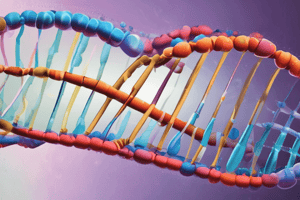Podcast
Questions and Answers
Describe the dispersive model of DNA replication.
Describe the dispersive model of DNA replication.
In the dispersive model, DNA replication results in two DNA molecules that are mixtures, or hybrids, of parental and daughter DNA. Each strand is a patchwork of original and new DNA.
Describe the conservative model of DNA replication.
Describe the conservative model of DNA replication.
In the conservative model, one DNA molecule consists of both original strands and another molecule consists of two new strands that have the same sequences as the original.
Describe the Semi-Conservative model of DNA replication.
Describe the Semi-Conservative model of DNA replication.
In the Semi-Conservative model, the two strands of DNA unwind and each acts as a template for a new complementary strand, resulting in two DNA molecules, each containing one original strand and one new strand.
What test organism did Meselson and Stahl use in their centrifuge experiment?
What test organism did Meselson and Stahl use in their centrifuge experiment?
What did Meselson and Stahl experiment with?
What did Meselson and Stahl experiment with?
What is an isotope?
What is an isotope?
List the steps of the Meselson and Stahl centrifugation experiment.
List the steps of the Meselson and Stahl centrifugation experiment.
Is 14N or 15N more dense?
Is 14N or 15N more dense?
What happened when Meselson and Stahl allowed E. coli to grow on a medium containing 15N?
What happened when Meselson and Stahl allowed E. coli to grow on a medium containing 15N?
How does the density gradient centrifugation method separate molecules?
How does the density gradient centrifugation method separate molecules?
What happens with ultra-centrifugation?
What happens with ultra-centrifugation?
How did the molecules band after centrifugation in Meselson and Stahl's experiment?
How did the molecules band after centrifugation in Meselson and Stahl's experiment?
DNTPS is shorthand for what?
DNTPS is shorthand for what?
What is a nucleotide triphosphate?
What is a nucleotide triphosphate?
What does the nucleotide triphosphate react with?
What does the nucleotide triphosphate react with?
What is polymerization?
What is polymerization?
What is a polymerization reaction catalyzed by?
What is a polymerization reaction catalyzed by?
What is the function of a polymerization reaction?
What is the function of a polymerization reaction?
What direction does a polymerization reaction move in?
What direction does a polymerization reaction move in?
Where do polymerization reactions get their energy from?
Where do polymerization reactions get their energy from?
What is required for the initiation of a polymerization reaction?
What is required for the initiation of a polymerization reaction?
What direction does DNA polymerase III move in?
What direction does DNA polymerase III move in?
DNA polymerase is template dependent.
DNA polymerase is template dependent.
List the initiator proteins in DNA replication.
List the initiator proteins in DNA replication.
Function of initiator protein.
Function of initiator protein.
Types of primosomes.
Types of primosomes.
How are primosomes formed?
How are primosomes formed?
Function of helicase.
Function of helicase.
Function of primase.
Function of primase.
What does SSBP stand for?
What does SSBP stand for?
Function of a single strand binding protein.
Function of a single strand binding protein.
Function of gyrase.
Function of gyrase.
Flashcards are hidden until you start studying
Study Notes
DNA Replication Models
- Dispersive Model: Results in hybrid DNA molecules with patches of parental and daughter DNA interspersed; strands are mixtures of old and new.
- Conservative Model: Produces one molecule that retains both original strands and one entirely new molecule; the parent duplex is conserved.
- Semi-Conservative Model: Each strand unwinds and serves as a template for a new strand; results in two DNA molecules, each with one old strand and one new strand.
Meselson and Stahl Experiment
- Test organism used: E. coli bacteria.
- Experiment involved growing E. coli in two nitrogen isotopes: 15N (heavy) and 14N (light).
- Isotope Definition: Different versions of an element based on neutron count.
- Experiment method included density gradient centrifugation to separate DNA based on density from the isotopes.
Steps of the Experiment
- E. coli cultured in 15N medium for several generations.
- After labeling, bacteria switched to 14N medium for growth.
- Samples collected across generations to assess DNA density changes.
Centrifugation Process
- High-speed spinning with cesium chloride creates a density gradient.
- Distinct bands formed after centrifugation based on DNA density; 15N more dense than 14N.
- Resultant bands reflected 14N/15N duplex medium density.
DNA Structure and Reactions
- dNTPs: Nucleotide triphosphates are highly reactive and essential for DNA synthesis.
- Nucleotide triphosphates react at the 3' carbon with incoming nucleotides to facilitate polymerization.
- Polymerization: Process where small molecules (monomers) combine to form large molecules (polymers), catalyzed by the polymerase enzyme.
Polymerization Characteristics
- Direction of polymerization is from 5' to 3'.
- Energy for reactions derives from incoming dNTPs.
- Initiation of polymerization requires an RNA primer.
DNA Polymerase
- DNA polymerase III: Functions in a 5' to 3' direction and is template-dependent.
- Initiator Proteins: Include DnaA, DnaB, and DnaC; they attach to DNA at the origin and cause local denaturation.
Primosomes and Related Functions
- Primosomes: Formed from helicase (DnaB) and primase (DnaC).
- Helicase: Untwists DNA strands to allow for replication.
- Primase: Synthesizes the RNA primer that provides a 3' hydroxyl (OH) for new strand synthesis.
Supporting Proteins and Enzymes
- SSBPs (Single-Strand Binding Proteins): Bind to exposed single strands of DNA to prevent degradation and renaturation.
- Gyrase: Reduces coiling ahead of the replication fork, easing the unwinding process.
Studying That Suits You
Use AI to generate personalized quizzes and flashcards to suit your learning preferences.




